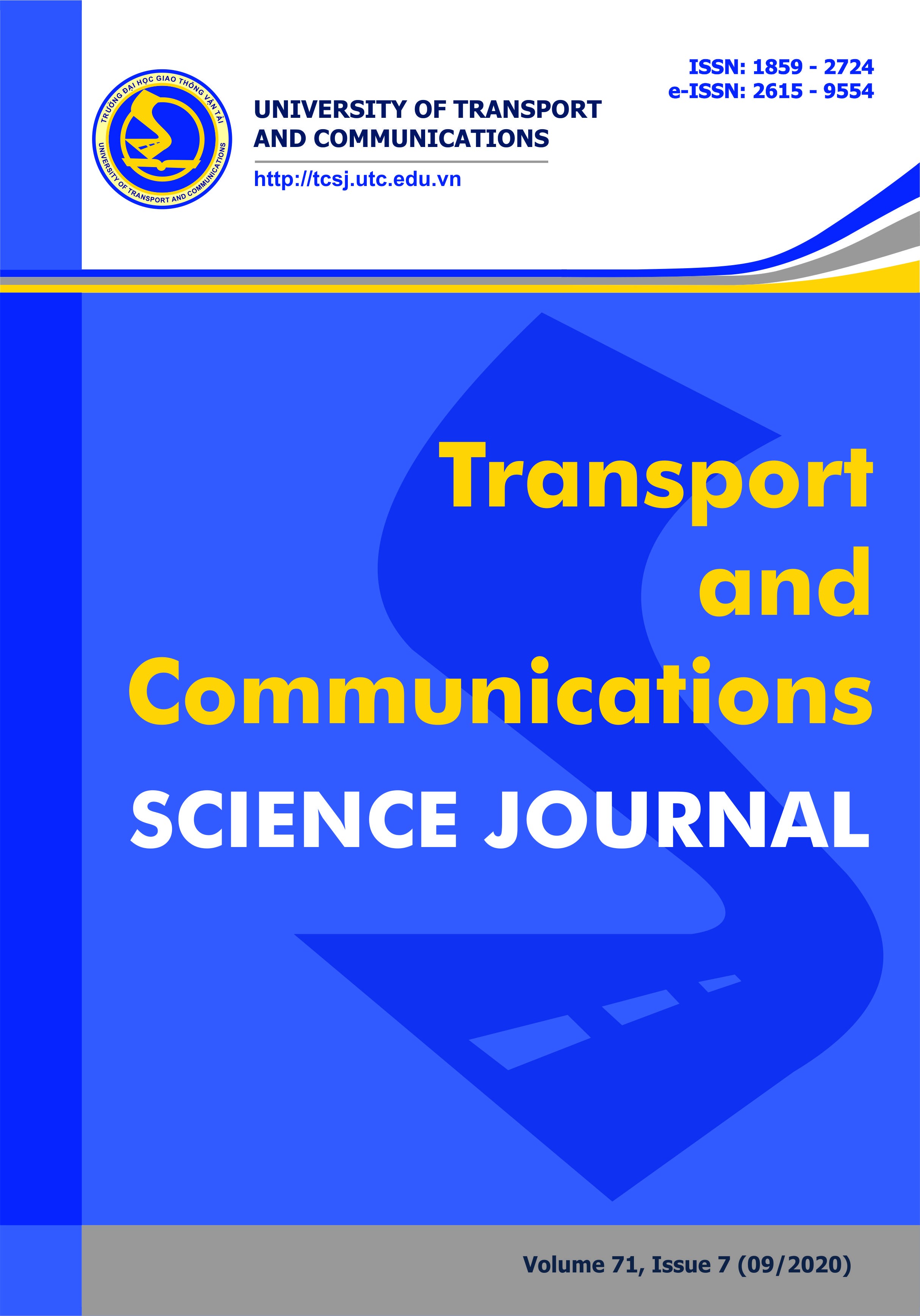A study of tensile strength of fractured rock mass by phase field method in DEAL.II with local refinement technique
Email:
dang.hong.lam@utc.edu.vn
Từ khóa:
fracture propagation, fractured rock mass, explicit modeling of fractures, DEAL.II, phase field method
Tóm tắt
Cracking propagation in elastic and porous media is still challenge topics in mechanical, energy, and environmental engineering. In this paper, the phase field method will be used to model the cracking propagation at the small scale for elastic media. This method is doing well in DEAL.II with the help of local refinement technique which allows studying the tensile strength of fractured rock mass behavior without prior knowledge of cracking propagation path and reduction of computational consumption. This implementation is applied to model a fractured rock mass in which a plenty of explicit fractures are distributed though total energy released by Griffith's criterion. Through these applications, we demonstrate and highlight the performance of the phase field method with local refinement technique in modeling crack propagation as well as investigate the tensile strength of fractured rock mass dependency its crack orientationTài liệu tham khảo
[1] T. Heister, M.F. Wheeler, T. Wick, A primal-dual active set method and predictor-corrector mesh adaptivity for computing fracture propagation using a phase-field approach, Comput. Methods Appl. Mech. Engrg., 290 (2015) 466–495. https://doi.org/10.1016/j.cma.2015.03.009
[2] A. Mikelic, M.F. Wheeler, T. Wick, Phase-field modeling of a fluid-driven fracture in a poroelastic medium, Computational Geosciences, 19 (2015) 1171–1195. https://doi.org/10.1007/s10596-015-9532-5
[3] A. Mikelic, M.F. Wheeler, T. Wick, A phase-field method for propagation fluid-filled fractures coupled to a surrounding porous medium, Multiscale Modeling and Simulation, 13 (2015) 367-398. https://doi.org/10.1137/140967118
[4] T. Wick, G. Singh, M.F. Wheeler, Fluid-filled fracture propagation with a phase-field approach and coupling to a reservoir simulator, SPE Journal, 21 (2015) 19 pages. https://doi.org/10.2118/168597-PA
[5] P. M. Pham, Anynasys free vibration of the functionally grade material cracked plates with varying thickness using the Phase-field theory, Transport and Communications Science Journal, 70 (2019) 122-131. (in Vietnamese) https://doi.org/10.25073/tcsj.70.2.35
[6] T. Mohammadnejad, A.R. Khoei, Hydro-mechanical modeling of cohesive crack propagation in multiphase porous media using the extended finite element method, Int. J. Numer. Anal. Meth. Geomech., 37 (2013) 1247-1279. https://doi.org/10.1002/nag.2079
[7] W. Bangerth, G. Kanschat, Concepts for object-oriented finite element software – the Deal.II library, Preprint 1999-43, SFB 359, Heidelberg (1999).
[8] W. Bangerth, R. Hartmann, G. Kanschat, Deal.II- a general purpose object oriented finite element library, ACM Trans. Math. Software, 33 (2007). https://doi.org/10.1145/1268776.1268779
[9] H.L. Dang, A hydro-mechanical modeling of double porosity and double permeability fractured reservoirs, PhD thesis, University of Orleans, France, 2018.
[10] H.L., Dang, P.H, Thinh, A methodology of re-generating a representative element volume of fractured rock mass, Transport and Communications Science Journal, 71 (2020) 347-358. https://doi.org/10.25073/tcsj.71.4.4
[11] A.A. Griffith, The phenomena of rupture and flow in solids, Philos. Trans. R. Soc. Lond., 221 (1921) 163–198. http://mbarkey.eng.ua.edu/courses/AEM644/Griffith1921fracture.pdf
[12] G. Francfort, J.-J. Marigo, Revisiting brittle fracture as an energy minimization problem, J. Mech. Phys. Solids, 46 (1998) 1319–1342. https://doi.org/10.1016/S0022-5096(98)00034-9
[13] J. Karlsson, Implementing Anisotropic Adaptive Mesh Refinement in OpenFOAM, Master’s Thesis in Computer Science, Algorithms, Languages and Logic, Chalmers University of Technology, Göteborg, Sweden (2012).
[14] L. Demkowicz, J. Oden, W. Rachowicz, O. Hardy, Toward a universal h-p adaptive finite element strategy, part 1. Constrained approximation and data structure, Computer Methods in Applied Mechanics and Engineering, 77 (1989) 79-112. https://doi.org/10.1016/0045-7825(89)90129-1
[2] A. Mikelic, M.F. Wheeler, T. Wick, Phase-field modeling of a fluid-driven fracture in a poroelastic medium, Computational Geosciences, 19 (2015) 1171–1195. https://doi.org/10.1007/s10596-015-9532-5
[3] A. Mikelic, M.F. Wheeler, T. Wick, A phase-field method for propagation fluid-filled fractures coupled to a surrounding porous medium, Multiscale Modeling and Simulation, 13 (2015) 367-398. https://doi.org/10.1137/140967118
[4] T. Wick, G. Singh, M.F. Wheeler, Fluid-filled fracture propagation with a phase-field approach and coupling to a reservoir simulator, SPE Journal, 21 (2015) 19 pages. https://doi.org/10.2118/168597-PA
[5] P. M. Pham, Anynasys free vibration of the functionally grade material cracked plates with varying thickness using the Phase-field theory, Transport and Communications Science Journal, 70 (2019) 122-131. (in Vietnamese) https://doi.org/10.25073/tcsj.70.2.35
[6] T. Mohammadnejad, A.R. Khoei, Hydro-mechanical modeling of cohesive crack propagation in multiphase porous media using the extended finite element method, Int. J. Numer. Anal. Meth. Geomech., 37 (2013) 1247-1279. https://doi.org/10.1002/nag.2079
[7] W. Bangerth, G. Kanschat, Concepts for object-oriented finite element software – the Deal.II library, Preprint 1999-43, SFB 359, Heidelberg (1999).
[8] W. Bangerth, R. Hartmann, G. Kanschat, Deal.II- a general purpose object oriented finite element library, ACM Trans. Math. Software, 33 (2007). https://doi.org/10.1145/1268776.1268779
[9] H.L. Dang, A hydro-mechanical modeling of double porosity and double permeability fractured reservoirs, PhD thesis, University of Orleans, France, 2018.
[10] H.L., Dang, P.H, Thinh, A methodology of re-generating a representative element volume of fractured rock mass, Transport and Communications Science Journal, 71 (2020) 347-358. https://doi.org/10.25073/tcsj.71.4.4
[11] A.A. Griffith, The phenomena of rupture and flow in solids, Philos. Trans. R. Soc. Lond., 221 (1921) 163–198. http://mbarkey.eng.ua.edu/courses/AEM644/Griffith1921fracture.pdf
[12] G. Francfort, J.-J. Marigo, Revisiting brittle fracture as an energy minimization problem, J. Mech. Phys. Solids, 46 (1998) 1319–1342. https://doi.org/10.1016/S0022-5096(98)00034-9
[13] J. Karlsson, Implementing Anisotropic Adaptive Mesh Refinement in OpenFOAM, Master’s Thesis in Computer Science, Algorithms, Languages and Logic, Chalmers University of Technology, Göteborg, Sweden (2012).
[14] L. Demkowicz, J. Oden, W. Rachowicz, O. Hardy, Toward a universal h-p adaptive finite element strategy, part 1. Constrained approximation and data structure, Computer Methods in Applied Mechanics and Engineering, 77 (1989) 79-112. https://doi.org/10.1016/0045-7825(89)90129-1
Tải xuống
Chưa có dữ liệu thống kê

Nhận bài
14/08/2020
Nhận bài sửa
15/09/2020
Chấp nhận đăng
15/09/2020
Xuất bản
30/09/2020
Chuyên mục
Công trình khoa học
Kiểu trích dẫn
Hong Lam, D. (8800). A study of tensile strength of fractured rock mass by phase field method in DEAL.II with local refinement technique. Tạp Chí Khoa Học Giao Thông Vận Tải, 71(7), 737-745. https://doi.org/10.47869/tcsj.71.7.1
Số lần xem tóm tắt
270
Số lần xem bài báo
261









